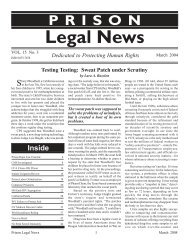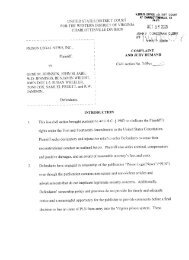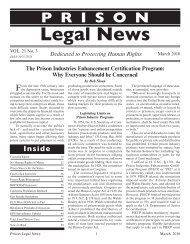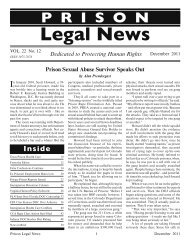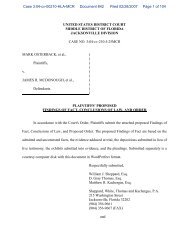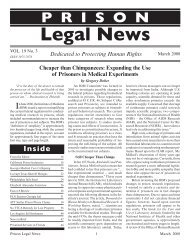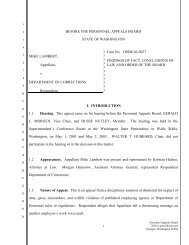From the Editor - Prison Legal News
From the Editor - Prison Legal News
From the Editor - Prison Legal News
You also want an ePaper? Increase the reach of your titles
YUMPU automatically turns print PDFs into web optimized ePapers that Google loves.
Cost Shifting (cont.)<br />
charged with a felony in <strong>the</strong> United State<br />
are indigent” based on Department of<br />
Justice data collected in 2000. 26 Saddling<br />
those least able to pay with an extra cost<br />
– beyond that assessed in general taxes<br />
– for running a justice system ostensibly<br />
designed to serve <strong>the</strong> public is both<br />
inequitable and unlikely to generate <strong>the</strong><br />
desired revenues. Predictably, researchers<br />
have found that “[s]taggering amounts<br />
of economic sanctions are unpaid, more<br />
than $4.5 billion in fines at <strong>the</strong> federal<br />
level and more than $166 million in New<br />
Jersey alone.” 27<br />
The current approach of levying costs<br />
has a particularly devastating effect on<br />
populations of color, communities disproportionately<br />
represented in <strong>the</strong> criminal<br />
justice system. At <strong>the</strong> end of 2005, 60<br />
percent of state and federal prisoners were<br />
African-American or Latino. 28 African-<br />
American women were more than twice as<br />
likely as Latina females and over 3 times<br />
more likely than white females to have<br />
been in prison on December 31, 2005. 29<br />
The Census Bureau’s most recent income<br />
and poverty figures show that African-<br />
American households had <strong>the</strong> lowest<br />
median income in 2005 ($30,858), 61 percent<br />
of <strong>the</strong> median for non-Latino white<br />
households ($50,784). 30 Median income<br />
for Latino households was 71 percent of<br />
<strong>the</strong> median for non-Latino, white households.<br />
31 In 2005, <strong>the</strong> poverty 32 rate was 24.9<br />
percent for African-Americans, with 9.2<br />
million people in poverty, and 21.8 percent<br />
of Latinos, with 9.4 million in poverty. 33<br />
For non-Latino whites, <strong>the</strong> poverty rate<br />
was 8.3 percent, or 16.2 million people in<br />
2005. 34 These prison and economic demographics<br />
show that communities of color<br />
are both disproportionately incarcerated<br />
EXECUTIVE CLEMENCY<br />
April 2008<br />
For Info on Sentence Reduction through<br />
Executive Clemency:<br />
NATIONAL CLEMENCY PROJECT<br />
8624 CAMP COLUMBUS ROAD<br />
HIXSON, TENNESSEE, 37343<br />
(423) 843-2235<br />
(33-Years of Clemency & Parole Assistance)<br />
and disproportionately impoverished.<br />
Legislators often create new fees<br />
and increase existing assessments without<br />
much, if any, information about <strong>the</strong><br />
system-imposed debts criminal defendants<br />
already face, or how those debts<br />
affect people’s lives. In 2003 alone about<br />
a third of <strong>the</strong> states enacted laws assessing<br />
costs against criminal defendants for<br />
court security, probation supervision,<br />
appointed counsel, transfer of parole or<br />
probation supervision to ano<strong>the</strong>r state,<br />
inmate medical and dental expenses, sex<br />
offender registration, electronic monitoring<br />
fees, and costs of incarceration, like<br />
room and board. In addition to enacting<br />
new fees some states increased existing<br />
assessments. 35 Illinois doubled its monthly<br />
probation fee (to $50), 36 Kansas doubled<br />
its assigned counsel application fee (to<br />
$100), 37 (which all defendants seeking a<br />
court appointed lawyer to represent <strong>the</strong>m<br />
at trial must complete). Minnesota upped<br />
its assigned counsel fee from $25 to $200, 38<br />
and Oklahoma quadrupled its monthly<br />
electronic monitoring fee to $300. 39<br />
George Keiser, Chief of <strong>the</strong> Community<br />
Corrections/<strong>Prison</strong> Division at<br />
<strong>the</strong> National Institute of Corrections, has<br />
studied <strong>the</strong> issue for decades. “Legislation<br />
imposing financial obligations has typically<br />
been passed incrementally,” Keiser<br />
observes, creating “a danger in tacking<br />
fees upon fees with no end in sight.”<br />
He suggests reviewing “<strong>the</strong> mandates in<br />
place before introducing new financial<br />
penalties.” 40<br />
With <strong>the</strong> growth of <strong>the</strong> adult correctional<br />
population – over seven million<br />
adults are in jail, prison, or supervised<br />
in <strong>the</strong>ir community 41 -- in <strong>the</strong> near term<br />
policymakers will continue to feel pressure<br />
to balance large, costly criminal justice<br />
system budgets. The temptation to shift<br />
<strong>the</strong> financial burden to <strong>the</strong> most politically<br />
powerless among us<br />
– those caught up in<br />
<strong>the</strong> criminal justice<br />
4<br />
system – is fierce.<br />
While <strong>the</strong> move may<br />
be popular with<br />
taxpayers and legislators<br />
eager to avoid<br />
raising taxes, any<br />
short-term gains in<br />
revenue come at <strong>the</strong><br />
cost of long-term<br />
community survival.<br />
Even <strong>the</strong> courts and<br />
criminal justice administrators<br />
who are<br />
<strong>the</strong> intended beneficiaries of cost-shifting<br />
economic sanctions are beginning to<br />
realize <strong>the</strong> futility of saddling those who<br />
reenter society with debt so crippling that<br />
any chances of successful reintegration<br />
may be impossible.<br />
An Overview of Criminal Financial<br />
Assessments<br />
“I’ve never seen so many people interested<br />
in $15!” 42<br />
— Probationer’s disbelief at paying<br />
multiple fees, as expressed on <strong>the</strong> wall of<br />
a probation office bathroom. 43<br />
A first step in understanding whe<strong>the</strong>r<br />
assessing cost-related fees is <strong>the</strong> appropriate<br />
way to defray <strong>the</strong> skyrocketing budget<br />
costs of state criminal justice systems is<br />
identifying <strong>the</strong> actual fees being assessed.<br />
An increasingly popular method for meeting<br />
<strong>the</strong> costs of expensive criminal justice<br />
systems is to recoup administrative costs<br />
from those arrested, prosecuted, incarcerated<br />
and supervised within criminal justice<br />
systems. 44 While states usually enact legislation<br />
authorizing assessment of fees at<br />
each stage of <strong>the</strong> criminal justice process,<br />
<strong>the</strong>se charges resemble landmines – <strong>the</strong>y<br />
are “hidden” and “scattered throughout<br />
every state code,” 45 and have <strong>the</strong> capacity<br />
to destroy financially those <strong>the</strong>y come in<br />
contact with. As a result, it is difficult for<br />
any given defendant, defense attorney, or<br />
even policymaker to fully comprehend <strong>the</strong><br />
financial sanction attached to a conviction<br />
or sentence.<br />
The National Institute of Correction’s<br />
first comprehensive analysis of economic<br />
sanctions, released in 1988, provided an<br />
overview of <strong>the</strong> types of financial consequences<br />
levied upon arrest, conviction,<br />
and sentence. 46 Fines, costs, and restitution,<br />
perhaps <strong>the</strong> most familiar forms of<br />
economic sanctions, are usually formal<br />
penalties explicitly set forth in <strong>the</strong> court’s<br />
Judgment and Sentence of <strong>the</strong> defendant,<br />
like <strong>the</strong> assessments Mr. Rideau faced.<br />
Fines are <strong>the</strong> traditional monetary penalty,<br />
usually imposed according to severity<br />
of crime, to punish an individual. Court<br />
costs are fees adopted and imposed by jurisdictions<br />
on most convicted persons, to<br />
cover a variety of court expenses that may<br />
include maintenance of court facilities,<br />
service of warrants, and law enforcement<br />
officers’ retirement funds. 47 Restitution<br />
is a court-ordered “payment by <strong>the</strong> offender<br />
to <strong>the</strong> victim for financial losses,<br />
and embodies both <strong>the</strong> just deserts notion<br />
of offense-based penalties and concern<br />
for <strong>the</strong> victim,” 48 and may be collected at<br />
<strong>Prison</strong> <strong>Legal</strong> <strong>News</strong>



